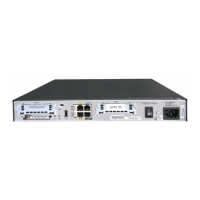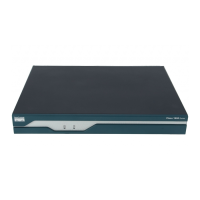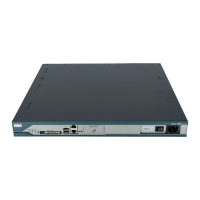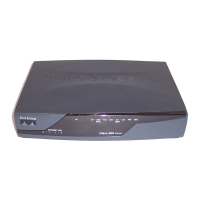4-5
Cisco 1800 Series Integrated Services Routers (Fixed) Hardware Installation Guide
OL-6425-03
Chapter 4 Power, Cable, and Antenna Connection Procedures
Connecting to a Console Terminal or Modem
Connection Procedures and Precautions
Follow these steps to connect your router to the network:
Step 1 Confirm that the router is powered off.
Step 2 Connect each WAN or LAN cable to the appropriate connector on the chassis. For locations of the
chassis WAN and LAN ports, see the
“Chassis Views” section on page 1-7.
• Position the cables carefully, so that they do not put strain on the connectors.
• Bundle the cables so that they do not intertwine.
• Inspect the cables to make sure that the routing and bend radiuses are satisfactory. Reposition
cables, if necessary.
• Install cable ties in accordance with site requirements.
Step 3 Connect the other end of each WAN or LAN cable to the appropriate network device. See Table 4-2 for
information about which network devices to connect each cable to.
Note For cable pinouts, see the Cisco Modular Access Router Cable Specifications document.
Connecting to a Console Terminal or Modem
Your router has asynchronous serial console and auxiliary ports for system management. These ports
provide administrative access to your router either locally (with a console terminal or PC) or remotely
(with a modem).
Cisco Systems provides the following cables for connecting your router to a console terminal, PC, or
modem:
Ta b l e 4-2 WAN and LAN Connections
Port or Connection Port Type, Color
1
1. Cable color codes are specific to Cisco cables.
Connection Device Cable
Ethernet
2
2. Ethernet connection information applies to both WAN ports and Ethernet LAN switch ports.
RJ-45, yellow Ethernet hub, Ethernet switch, or
Ethernet network interface
card
(NIC)
Category 5 or higher Ethernet
ADSL RJ-11C/CA11A,
lavender
Network demarcation device for
service provider DSL interface
RJ-11 straight-through
SHDSL RJ-11C/CA11A,
lavender, RJ-14
Network demarcation device for
service provider DSL interface
RJ-11 straight-through for 2-wire
RJ-14 straight-through for 4-wire
BRI S/T WAN
(external NT1)
RJ-45/CB-1D, orange NT1 device or private integrated
services network exchange (PINX)
RJ-45 straight-through
Analog Modem RJ-11 PSTN RJ-11 straight-through
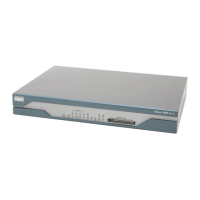
